5 The Reality of Cyborgs and a Look into the Future [Johnson]
LEARNING OUTCOMES
- The future of enhanced humans- explore the potential for our military, commercial and medical status.
- Understand the practical side of enhancing human capabilities and merging with machines
- Look into the future, explore a framework for humanities acceptance of Cyborgs/Enhanced Humans
An important scientific innovation rarely makes its way by gradually winning over and converting its opponents: it rarely happens that Saul becomes Paul. What does happen is that its opponents gradually die out, and that the growing generation is familiarized with the ideas from the beginning: another instance of the fact that the future lies with the youth.
Paraphrased as “Science progresses one funeral at a time”.
— Max Planck (Planck, 1949)
WHAT IS A CYBORG?
The Merriam-Webster dictionary definition is “a bionic human” (Merriam-Webster, 2023) whereas the Britannica’s expands the definition to “a person whose body contains mechanical or electrical devices and whose abilities are greater than the abilities of normal humans” (Britannica). The term is a popular theme in science fiction. Futurists are considering the theory and application. Modern science and medicine is well on its way to realizing the definitions and pop culture references of cyborg in modern society. At its most base comparison, a human with a prosthetics, by the definitions cited, could be (and in some cases, are) considered a cyborg.
This chapter will define what a cyborg is and how they are created, the current medical and scientific research into enhanced humans inclusive of those who already consider themselves cyborgs and what direction society is heading regarding human minds, bodies, and limbs whose enhanced abilities far outreach those who are not. Risks will be considered, narrowly focusing on risks to society and to the enhanced humans themselves. The working definition of Cyborgs for this text will be Cyborgs are enhanced humans with increased capability resulting in increased human abilities.
This chapter complements chapter 12 later in this text. The student reader will understand enhanced human’s potential to enable the future, understand the practical side of enhancing human capabilities and merging with machines creating a framework for humanities acceptance of Cyborgs/Enhanced Humans.
HOW ARE CYBORGS CREATED?
Increasing human capability through mechanical or electrical means resulting in improved biological, bio-mechanical or neurological human abilities. Mechanical means are inclusive of the range of prosthetics that allow veterans who’ve lost limbs sustained in combat the ability to walk, to grab items through the pioneering research at the Massachusetts Institute of Technology (MIT) in the field of Agonist-antagonist Myo-neural Interface (AMI), a method to restore proprioception to persons with amputation, or the ability of amputees to feel and have better control of their prosthetic limbs (MIT Media Lab). Physical implants like those of Amal Graafstra whose radio frequency ID chips implanted in his hands allowing him to start his motorcycle (Swain, 2014) and remotely open doors; and Rob Spence, who lost vision in his right eye, then implanted a tiny camera, producing a documentary about his life as a cyborgs (Swain, 2014). Future neurological advancements predict brains implanted with chips that are modified by DNA.
Medical and scientific research into prosthetics is the precursor to future advancement into cyborgs, cybernetics, and the human-machine interface. The field covers advancements in the medical, scientific, and commercial communities. The human-machine interface is inclusive of wearable technology to implanted technology. Three current examples of medical, scientific, and commercial cyborg creation are Dr Stephen Mann, who promotes wearable technology, Neil Harrison, a color-blind artist whose neurological implant allows him to hear sound, and Hugh Herr at MIT builds prosthetic knees, legs and ankles that fuse biomechanics with microprocessors to restore (and enhance) normal gait, balance, and speed.
Stephen, Neil, and Hugh, and those cited above, chose their implants. They made the concise decision to fuse mechanical, electrical and computer technology into their human form, increasing their human capability. In his 2018 TED talk, Hugh Herr envisions that by the end of the 21st Century, nervous systems will be linked to exoskeletons, augmenting humans’ strength, and power. He extrapolates this human augmentation into non-anthropomorphic structures such as wings, allowing humans the ability to fly (Herr, 2018).
Figure 5-1 Neil Harbisson, a color-blind artist whose neurological implant allows him to hear sound
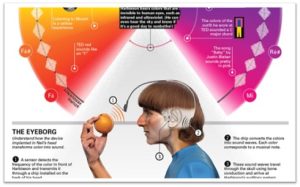
Source: (Walters, 2013)
Figure 5-2 Steve Mann’s wearable computer
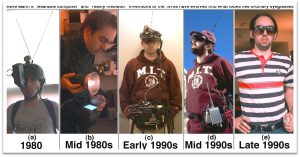
Source: (Case, 2013)
This generates questions on the future legal and moral structure for human-machine modification. Who gets to approve modifications? When in the human growth cycle can (or should) modifications be made? Will modifications become genetic, or remain implants? Before reaching legal maturity, much less physical or mental maturity, where does the decision reside, with the parents or the individual? What will be the societal impacts? How much government oversight will there be regarding regulations and oversight? Much less religious and political ramifications.
HOW ARE MODIFICATIONS MADE?
Most of the progress in current medical and scientific technology is limited to surgical implants, and prosthetics. Other research and innovation include the world of wearable computing. Dr Mann considers himself a cyborg promoting a cyborg lifestyle. His experiments in wearable computing follows Moore’s Law, from the late 1970’s evolving from backpack computers through augmented reality eyeglasses of the 2020’s (Case, 2013). Dr Mann’s view includes “unlike other computers (including laptops and PDAs), a WearComp is inextricably intertwined with its wearer – WearComp’s ‘always ready’ characteristic leads to a new form of synergy between human and computer” (Mann, 2012).
This coincides with research into robotics and computing, the fields of creating android, and human-like machines. The advances in Artificial Intelligence, machine learning, robotics, engineering, and nanotechnology all portend cross-over potential between robotics research and cyborg research. Machines and robots will eventually possess the capacity to learn. Artificial Intelligence’s end state is to replicate human intelligence, to reason, discover meaning, to generalize, and perform (McCarthy, 2006). Machine Learning, a sub-field of AI, allows the computer to learn without programming (Brown, 2021). Following Moore’s law, it is inevitable that the distinct areas of research, development, and implementation of AI and robotics will eventually merge with the medical and scientific research in bionics and wearable technology, creating cyborgs.
In Darwin’s The Origin of Species, he writes “Natural Selection, as we shall hereafter see, is a power incessantly ready for action, and is immeasurably superior to man’s feeble efforts, as the works of Nature are to those of Art.” (Darwin, 1859). Evolution can be characterized by adaptation for survival. Humans environmental and climate change adaptation is exhibited by the differences in skin pigmentation. We have evolved from hunter-gathers to the domestication of animals and grains leading to an agrarian society (Max, 2017). Humanity’s current stage of evolution results from environmental pressure coupled with our own nature to improve the world around us through technological and scientific progress The modern era is no different, driven by medicine to restore their fellow humans’ abilities, to science to increase humanities capabilities, humanity is evolving. Into cyborgs.
Figure 5-3 Evolution of Cyborg

Source: (Kytaiko, 2023)
THE CURRENT STATE OF CYBORGS (2023)
Neil Harbisson was born with achromatopsia, total color blindness. Rob Spence lost vision in his left eye. Adrianne Haslet-Davis lost her foot in the Boston Marathon terror attack in 2013. All have chosen to become cyborgs through medical procedures. Neil hears color through a fiber optic device and microchip implanted in his skull. The antenna, above his right eye “…picks up the colors in front of him, and a microchip implanted in his skull converts their frequencies into vibrations on the back of his head. Those become sound frequencies, turning his skull into a sort of third ear” (Max, 2017). Rob Spence lost sight in his right eye after a weapons accident as a teenager. He chooses to replace his eye with a miniaturized camera, recording his life first person point of view of the world, declaring himself an Eyeborg (Kell, 2010). Adrianne Haslet-Davis, a ballroom dancer lost her left leg in the 2013 terror attack on the Boston Marathon (Thompson, 2022). MIT’s Media Lab, built her a bionic limb, enabling her to regain her dancing life, through research expertise in prosthetics, robotics, machine learning and biomechanics (Herr, 2014).
The current state of medical research and surgical procedures combining machines with man will yield enhanced humans, cyborgs whose abilities exceed those of their fellow humans. This section will explore the current state (as of 2023) of research, development, and the lives of cyborgs. Along with prosthetics, eye replacements, and bionics, the areas of brain-computer interfaces, Agonist-antagonist Myoneural Interface (AMI), subdermal microchips, and exoskeletons are going to be reviewed.
Rob Spence lost his playing with a gun at age 13. As an adult, he has replaced his eye with a prosthetic eye fitted with a camera, recording his life as a “Eyeborg” (Warrick, 2017). His bionic eye, described as more a spherical contact lens, consists of a battery, video camera, video transmitter, attached to a circuit board (Spence, 2014). The company Second Sight’s product, the Argus II, “…converts images from cameras, into signals that the electrodes implanted in the eye can use, and that the brain can interpret. The Argus II allows Fran Fulton, 66, who is blind due to retinitis pigmentosa – a degenerative eye disease that slowly causes light-sensitive cells in the retina to die off, too see again through her camera equipped glasses. The Argus II is early in its development, allowing Fran and the other 6 people equipped to see black & white pixelated image. Second Sights next phase seeks to skip the retinal layer, and implant electrodes into the visual area of the brain (Eveleth, 2014).
Figure 5-4 Rob Spence, Eyeborg

Source: (BBC Click, 2017)
Figure 5-5 a& b Detail of Rob Spence prosthetic eye.
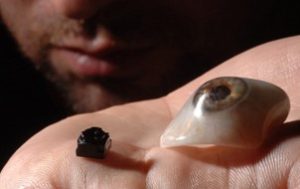
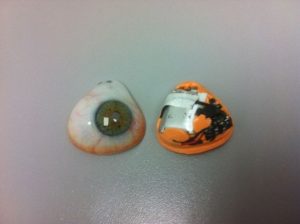
Source: (Ghose, 2017)
MIT (as of March 2023) uses a Microsoft HoloLens to design implement augmented reality (AR) system with non-line-of-sight perception. This system augments AR headsets with radio frequency (RF) sensing enabling the operator to see RFID tagged objects that are normally outside the spectrum of light for the human eye. The tech utilizes innovative algorithms, radiation and bandwidth capabilities, and localization of line-of-sight and non-line-of-sight objects. A driver for this innovative tech is the desired effect boosting efficiency in manufacturing, warehousing, logistics, and retail. The outcome is creating efficiency in worker labor by “…by visualizing assembly tasks, automatically labeling tools in the environment, and helping users find parts they need. More generally, AR head- sets are expected to make workers more efficient by an- notating their environments, visualizing their next tasks, and guiding them in executing these tasks (Boroushaki, Lam, Dodds, Eid, & Adib, 2023).
Figure 5-6 Augmented Reality SAR
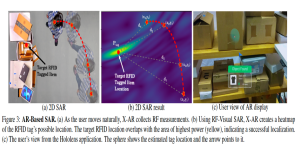
Source: (Boroushaki, Lam, Dodds, Eid, & Adib, 2023)
Figure 5-7 VAR & RF-visual in hand verification
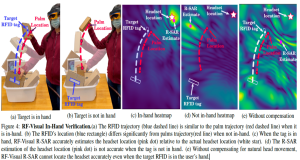
Source: (Boroushaki, Lam, Dodds, Eid, & Adib, 2023)
In 1998, Kevin Warwick, a professor of Department of Cybernetics at the University of Reading, self-experimented with a silicon chip implanted in his arm allowing a computer to monitor his movements. Communicating via radio waves to a network of antennas that transmitted signals to a computer programmed to respond to his actions, a voice box saying “hello” as he entered rooms, or doors opening on his approach. His first self-experiment consisted of a glass-capsule implanted under his skin, on top of the muscles. His following attempt will focus on “biomedical signal processing – i.e., creating software to read the signals the implant receives from my nervous system and to condition that data for retransmission” (Warwick, 2000). Warwick’s self-experiments complement research at Neural Engineering Clinic in Augusta, Maine using technology treating patients with damaged central nervous systems to achieve basic muscle function and at Emory University, Atlanta, GA, who implanted a transmitter in the brain of a stroke patient transmitted a signal from the brain to a computer operating it (Warwick, 2000).
Neuro-prosthetics, a multidisciplinary filed at the intersection of neurosciences and biomedical engineering, whose focus is replacing or modulating areas of the nervous system impaired through disease degeneration or accident. For 60 years, the field has evolved to the point of commercial application of the tech treating cognitive functions and memory issues (Gupta, Vardalakis, & Wagner, 2023). Brain Machine Interfaces (BMI) or are “device that translates neuronal information into commands capable of controlling external software or hardware such as a computer or robotic arm. BMIs are often used as assisted living devices for individuals with motor or sensory impairments.” Brain Control Interfaces (BCI) a system that analyzes signals from the central nervous system and translates them into machine commands (Nature, 2023). Synchron is a neural interface company that designs and develops an endovascular, implantable brain-computer interface, which allows a patient’s thoughts to be transmitted wirelessly through the skin to control an array of digital devices (Zomorodi, Gutierrez, & Meshkinpour, 2023). Their product Stentrode — “an implantable brain-computer interface that collects and wirelessly transmits information directly from the brain, without the need for open surgery” During human trials, Phil O’Keefe, whose paralysis cannot use his hands or fingers, is able to Tweet his thoughts using Synchron’s tech using blue-tooth (Oxley, 2022).
Figure 5-8 Brain Control Interface
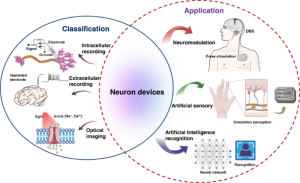
Source (Gupta, Vardalakis, & Wagner, 2023)
Figure 5-9 Development of neuron devices
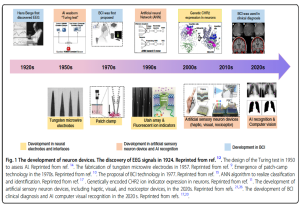
Source: (Wang, Liu, Wang, Zhao, & Zhang, 2022)
Bionics, as defined by Britannica, is the science of constructing artificial systems that have some of the characteristics of living systems (Britannica, 2022). Merriam-Webster defines cybernetics as the science of communication and control theory that is concerned especially with the comparative study of automatic control systems (such as the nervous system and brain and mechanical-electrical communication systems) (Merriam-Webster, 2023). They both use the study of living systems, bionics searching for innovative uses of machines and systems, where cybernetics pursues the reason behind living beings control systems and processes.
Human augmentation, the addition of robotic body parts that increase our capability, is being worked on at Cambridge University. They have designed a 3D thumb to be added to any hand. Dani Clode, the designer, stresses that, in addition to assisting those missing limbs, the augmented thumb does not take away from the user, seeking to increase ability and capability. This device, instead of using brain control interface, is “connected to two wrist-based motors that are hooked up to a battery and microcontroller on the upper arm. This system is wirelessly connected to microcontrollers mounted on the wearer’s shoes or ankles, which are connected to pressure sensors underneath the two big toes.” (Davis, 2023)
Prosthetics range from a simple replacement limb to limbs that can manipulate objects, hands that grasp, and lower limbs that articulate at joints to emulate movement. Simple prosthetics that can grasp are designed as described above, the wearer manipulates an interface to articulate the prosthetic hands. In the Massachusetts Institute of Technology labs, they are conducting research and application into Agonist-antagonist Myoneural Interface (AMI) and Neuro-Embodied Design. AMI closes the gap in conventional prosthetics providing the wearer proprioception, the ability to sense position, speed, and torque of their limbs, allowing precise control of their limbs. AMI’s goal is to restore amputees with proprioception (Hsieh).
Figure 5-10 Agonist-antagonist Myoneural Interface (AMI) and Neuro-Embodied Design
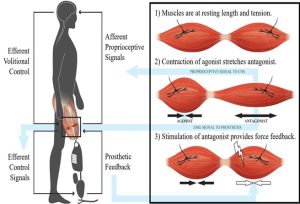
Source: (Hsieh)
Figure 5-11 Agonist-antagonist Myoneural Interface (AMI) and Neuro-Embodied Design
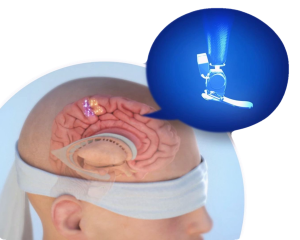
Source: (Hsieh)
Dr Hugh Herr, of the MIT Media Lab, director of the biomechatronic research group and co-director of the MIT Center for Extreme Bionics, describes bionics as “this glorious interplay between biology and engineering design.” He himself is a double amputee who enjoys full ability to walk, run and climb due to AMI and neuro-embedded design which he describes as a method to “co-design the biological body with [a] synthetic construct to maximize bi-directional communication between the device and the human nervous system.” (Snyder, 2021). Or, a bionic limb, powered by a computer, that sends and receives signals from the central nervous system. AMI and neuro-embedded design’s practical effects are demonstrated in two TED talks by Dr Herr, culminating in the stories of Adrianne Haslet-Davis, who lost her leg in the Boston Marathon bombing, re-gaining the ability to climb again (Herr, 2014) and Jim Ewing, regaining the ability to mountain climb (Herr, 2018).
Figure 5-12 Dr. Hugh Herr & AMI prosthetic legs
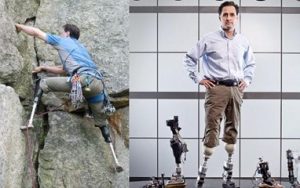
Source: (Dann, 2015)
Figure 5-13 Dr. Herr & Adrianne Haslet-Davis, a ballroom dancer lost her left leg in the 2013 terror attack on the Boston Marathon
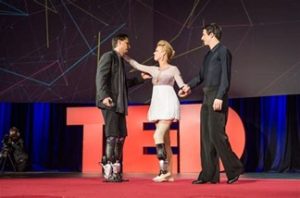
Source: (Bast, 2014)
In an anatomical sense, an exoskeleton is a rigid or articulated envelope that supports and protects the soft tissues of certain animals (Editors of Encyclopedia Britannica, 2017). In human sense, an exoskeleton is application of robotics and biomechatronic towards the augmentation of humans in the performance of a variety of tasks (Exoskelton Report). In simpler terms, an exoskeleton is a tool, using robotics, that exponentially increases the capability of the human form. The International Federation of Robotics classifies robots in two sectors, Service Robots and Manufacturing Robots (Muller, 2022), where exoskeletons can cross-over into both realms. One source that provides a survey of the exoskeleton sector adds Consumer, Industrial, Medical and Military applications to the mix. The ExoskeletonReport.com identifies 120 companies (as of April 2023) that provide exoskeletons in one (or more) of their categories (Exoskelton Report).
Consumer applications include sports and educations exoskeletons. Industrial applications range from arm, back and limb support to tools use and powered gloves. The medical applications garner the largest range of applications and companies provide exoskeletons. Medical uses include upper and lower body fixed and mobile rehabilitate and assistive functions (Exoskelton Report). Medical exoskeletons support faster therapy, recovery and rehabilitation from injuries or damage to the central nervous system including exoskeletons enabling wheelchair bound patients the ability to stand, walk, turn and climb (2020). The smallest tracked category, the military sector, possess the potential to have the most outsized impact on the military and civilian sector. The initial aim of military applications is to create a distinct advantage to Soldiers to accomplish their mission and complete their task. Harvard’s Wyss Institute for Biologically Inspired Engineering, in partnership with the Defense Advanced Research Projects Agency (DARPA), develop exoskeletons that reduce fatigue and minimize Solider injury. DARPA TALOS (Tactical Assault Light Operator Suit) projects goals is to develop an exoskeleton that us “Engineered with full-body ballistics protection; integrated heating and cooling systems; embedded sensors, antennas, and computers; 3D audio (to indicate where a fellow warfighter is by the sound of his voice); optics for vision in various light conditions; life-saving oxygen and hemorrhage controls” (Jacobson, 2015).
Figure 5-14 DARPA conception of an Exoskeleton for Soldiers

Source: DARPA Warrior Web Program
Figure 5-15 The Human Universal Load Carrier, or HULC

Source: Lockheed Martin – HULC & (Edwards, 2012)
The word “cyborg,” coined by Manfred Clynes (1960), is a combination of “CYBernetic” and “ORGanism” (cyborg conference INTRO). In this text, the working definition of a cyborg is the increase in human capability through mechanical or electrical means resulting in improved biological, bio-mechanical or neurological human abilities (author, 2023). Further classifying cyborgs into a taxonomy would be helpful later when discussing the legal, moral, and ethical status of cyborgs. Futurists are establishing a theoretical discussion of class and type of cyborg to set a framework. From the 2021 Cyborg Conference, Monika Michalowska, Steve Fuller and Steve Mann provide a “fundamental taxonomy of cyborgs: a Type I cyborg is one in which a human enters a vessel or other environment (e.g., boat, “wearables,” spacesuit), and a Type II cyborg is one in which a vessel enters a human (e.g., “implantable”), or hybrids of Type I and Type II (Mann et. al., 2021).” (Michalowska, 2021). Cyborgs taxonomy can be further categorized in division and category based on structure and role. The division of cyborgs could be biomedical cyborgs, digital cyborgs, and robotic cyborgs. Categorization could include material cyborgs and information cyborgs (Michalowska, 2021).
WHERE ARE WE HEADED (WITH CYBORGS)?
General (retired) Paul Gorman described a version of 21st Century Cyborg warriors for DARPA in 1985. He described a “integrated-powered exoskeleton” that “…offered protection against chemical, biological, electromagnetic, and ballistic threats, including direct fire from a .50-caliber bullet” and “incorporated audio, visual, and haptic [touch] sensors”. He imagined that each “each soldier would have his own physiological specifications embedded on a chip within his dog tags. And “he would insert one dog-tag into a slot under the chest armor, thereby loading his personal program into the battle suit’s computer.” (Jacobson, 2015). In Annie Jacobson’s article, she reminds the reader “That connecting the human brain to a machine would produce a matchless fighter has not been lost on DARPA.”
Imagine the combing of the current medical and tech research, development and practical in robotics, bionics, prosthetics, brain-machine/brain-computer interfaces into a Cyborg, the combination of human, computer and machine that exceeds human capability. In the previous section, we described the current state of Cyborgs, all external to the human body. But what of internal to the brain and body? At the atomic level and neural level. This section will discuss Nanotechnology, neuro-interfaces, and neural networks.
Nanorobots are microscopic machines small enough to flow through human blood veins. One use of nanorobots that is applicable to Cyborgs is real-time monitoring and imaging. Nanorobots can be outfitted with monitors, sensors, and the capability to deliver medicine at the cellular level as well as the potential to conduct surgical procedures at the nano-level. Potential uses of sensors include real-time monitoring of physiological parameters of blood pressure, heart rate, and glucose levels. The monitor nanorobots would be fitted with transmitters to communicate with medical personal in real-time. Imaging sensors allows doctors to see the level of detail not available in current X-ray, MRI, and CTI scans. Nanorobots, controlled by doctors could perform minimally invasive procedures and deliver medicine to the cellular level increasing their effectiveness and reduce surgical complications (Saikia, 2023).
In Section II, Brain-Machine Interface (BMI) and Brain-Control Interfaces (BCI) discussion focused on the devices that are implanted in human’s brain’s that are capable of transmitting control signals to external devices and chips implanted to monitor the central nervous systems sending signals to external devices. Parkinson’s Disease, Alzheimer’s and paralyzed patients benefit from BMI & BCI, regaining some of their cognitive functions and the ability to control prosthetics limbs. The field of Artificial Intelligence (AI), whose end state is to replicate human intelligence, to reason, discover meaning, to generalize, and perform (McCarthy, 2006) using machine learning, big data and algorithms possess the potential to advance the field of neural interfaces. Neural interfaces could combine current BMI & BCI with AI to exponentially expand human capability.
Figure 5-16 BMI & BCI for sensorimotor disorder
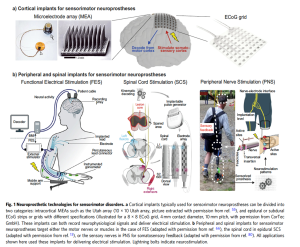
Source: (Gupta, Vardalakis, & Wagner, 2023)
Figure 5-17 BMI & BCI for bi-directional thought control of prosthesis
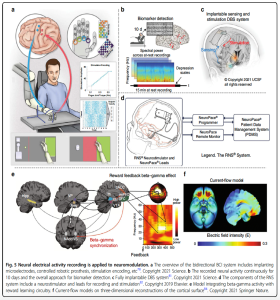
Source: (Wang, Liu, Wang, Zhao, & Zhang, 2022)
Neural interface is linking an AI brain chip with an external AI interface to communicate with machines and the external world just with thoughts (Saikia, 2023). Current neuron interfaces include devices for intracellular recordings, extracellular recordings, and optical imaging recording (Wang, Liu, Wang, Zhao, & Zhang, 2022). A 2022 article from Nature.com Microsystems & Nanoengineering section presents a survey of current and future AI Neural interface pathways including:
- Neuromodulation, the stimulation, or chemical substances applied directly to the nervous system to modify nerve cell activity.
- Bi-directional feedback for BCI control of prosthetics.
- Increased Artificial sensory neuron devices, which could “mimic complicated sensing and processing functions in biological systems, which can convert external stimuli into electrical signals”
- Artificial neuron sensory devices for mimicking the human sensory system. Bimodal artificial sensory neuron (BASE) realized the fusion of visual and haptic modalities. Pressure sensors and photodetectors are the major components of the BASE patch. Visual feedback and tactile feedback were used to create the movement of a robot’s hands
- Artificial intelligence memory and recognition, A high-performance electronic device was designed to train hippocampal neurons to learn by activating their memory function through electrical stimulation. A high-performance electronic device was designed to train hippocampal neurons to learn by activating their memory function through electrical stimulation. Based on retinal photoreceptors and bipolar cells for motion detection and recognition (MDR), the two-dimensional retinal neuron hardware integrated three modules of optical perception, memory, and recognition.
- An all-optical pulse neuron device was designed to accomplish the AI task of pattern recognition. The neural network simulated by this integrated design can self-learn to complete simple recognition tasks, and it runs several orders of magnitude faster than biological neural networks; thus, it can process large amounts of data in a short time.
Figure 5-18 Timeline of BCI & AI development

Source: (Wang, Liu, Wang, Zhao, & Zhang, 2022)
A human’s cognitive perception of its external environment is a complicated fusion of multiple sensory inputs. The implications of neural networks and Artificial Intelligence stands to aid in cyborg development. The current challenges of efficiency and biosafety of materials will have to be solved for AI enabled neural networks to be realized, outside of current research and development. The Figure below depicts current and future areas for the prospects of neuron interfaces. The article and survey conclude it best stating “AI technology can be used to achieve fast and efficient data processing. Combining AI with BCI and exploiting neural network algorithms will propel the development of neuron devices and improve neuroscience research” (Wang, Liu, Wang, Zhao, & Zhang, 2022)
Figure 5-19 Prospects of BCI

Source: (Wang, Liu, Wang, Zhao, & Zhang, 2022)
Where does genetic engineering fit into the development of cyborgs? Genetic enhancement covers the willful alteration of genes to be more than human, be it strength, cognition, or other traits. Genetic enhancements parallel cyborg enhancements as they alter the human form resulting in increased capability. It is important to note the downstream effects of genetic enhancements. If a genetic enhancement only applies to one individual, then the genetic line remains normal, it is when the genetic modifications enter the gene pool, will the line be passed on to future generations and change the human genome (Barfiled, 2022). There is much debate on the efficacy, legality, moral, ethical, and societal effects of deliberate genetic modification, some of which will be discussed in the following sections. As this chapter focuses on cyborgs, the enhancement of human capacity with machines, gene therapy, the delivery of “a copy of a normal gene into the cells of a patient in an attempt to correct a defective gene” (Barfiled, 2022) will not be discussed beyond the above general explanation for awareness.
CYBORGS, WHAT ARE THE RISKS?
“Neuro-prosthetic devices and implants that are connected to an internal network that is itself connected to the Internet, and that are also vulnerable to infections from laptops or other device. The problem of implants being affected with a software virus is exacerbated by the fact that manufacturers often will not allow their equipment to be modified, even to add security features.” (Barfiled, 2022)
RISK TO SOCIETY, A PERSPECTIVE
As a noun, risk means someone or something that creates or suggests a hazard. And as a verb, it is defined as to incur the risk or danger of (Merriam-Webster, 2023). So “Risk” implies a hazard or danger. Broadly thinking, is there danger or hazard posed by Cyborgs? Conversely, is there danger or hazard to Cyborgs? This section will illuminate the topics of risk and Cyborgs, the risk to Cyborgs and what is the risk posed by Cyborgs.
What could be the risks of a cyborg? Would general society accept Cyborgs? Conversely, would Cyborgs want to be considered human by societies definitions? Would the answers change when replacing society with “government.” In a world with finite resources, many of the advancements described above are currently in the research & development phase. Once Cyborgs are accepted, once the Singularity occurs, what is the risk to the acquisition of components required for industrial scale production of Cyborgs?
A 2022 Pew Research topic of AI and Human Enhancement provides some prospective of what the public’s understanding and acceptance of enhanced human, Cyborgs, is. The survey covers six topics in the advancement of AI and human enhancement that possess the potential to alter society, a few of which are germane to this section, the possibilities of enhanced humans, enhanced cognitive function from computer chips implanted in the brain, and exoskeletons with AI in the workforce. In 2022, caution is the fundamental theme of the survey results. Caution relating to AI and human enhancements effect on the disparities between humans and enhanced humans and the unintended consequences of these advancements and developments. (Rainie, Funk, Anderson, & Tyson, 2022).
The survey results run the gamut of American public reactions to Cyborgs, and the related technology advancements. Some findings include:
- For societal benefits, more Americans view the good over bad in the use of robotic exoskeletons with a built-in AI system to increase strength for manual labor jobs (33% vs. 24%).
- Americans are cautious about a future with widespread use of computer chip implants in the brain to allow people to process information far more quickly and accurately: 56% say this would be a bad idea for society, while just 13% think this would be a good idea.
- Uncertainty is among the themes seen in emerging public views of AI and human enhancement applications. For instance, 42% are not sure how the widespread use of robotic exoskeletons in manual labor jobs would impact society. 45% say they are equally excited and concerned about the increased use of AI programs in daily life, compared with 37% who say they are more concerned than excited and 18% who say they are more excited than concerned.
Figure 5-20 Pew Research Center Data
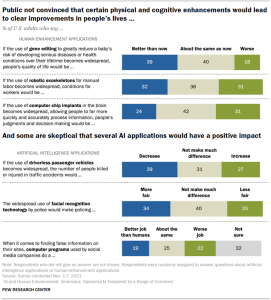
Source: (Rainie, Funk, Anderson, & Tyson, 2022).
Figure 5-21 Pew Research Center Data
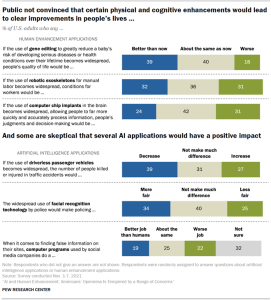
Source: (Rainie, Funk, Anderson, & Tyson, 2022)
What is agreed upon across the board, are the mitigating steps making the applications of human enhancement acceptable into society. For example, 7 in 10 would find driverless cars acceptable if they were labeled as such and easily identifiable. In terms of computer chip enhancements in the brain, acceptability rose if the effects could be turned on or off and implanted without surgery. Over 40% of survey respondents are more excited about the potential of enhancements that provide health benefits or disease prevention. Interestingly, 8 in 10 would “opt against” computer chip enhancements for themselves yet 6 in 10 respond that there will be societal pressure to allow and receive these implants should they become widely available. The public are more accepting of enhancement that can be turned on or off, such as exoskeletons, than they are a brain implants that increase cognitive function (Rainie, Funk, Anderson, & Tyson, 2022).
Two interesting concerns from the Pew Research survey highlight potential risks to Cyborgs and society, the unintended consequences of cyborg enhancements, and the amount at type of government oversight and regulation. The major concerns highlighted include hackers gaining access to personal information, unwanted changes to the brain and chip malfunctions. The concern for government regulation lie along the lines of what is “enough” regulation and oversight, in the development of enhancements. What risks constitute regulation, such as the Indiana (and 10 other states) banning employers from requiring workers having devices implanted in their bodies (Marr, 2020). The survey does address the socio-economic and religious impact from respondents view-points, that enhancements “meddle with nature” and potentially increase the social-economic gap between enhanced humans, a valid concern outside the scope of this section (Rainie, Funk, Anderson, & Tyson, 2022).
Figure 5-22 Pew Research Center Data
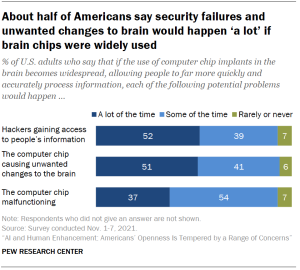
Source: (Rainie, Funk, Anderson, & Tyson, 2022)
The Pew Research is one viewpoint of the risks of Cyborgs, from a societal perspective. What of the risk to cyborgs themselves? Looking at the current the advancements in Cyborg research, technology, and implementation discussed in Section III, the question of risks, vulnerabilities, impacts, and countermeasures are relevant to the safety of the cyborg, and the security of the technology (including personably identifiable and personal health information).
RISK TO CYBORGS, A CASE STUDY
Section III covers the current state of Cyborgs. The research, development and current technologies include eye replacements, implanted microchips/RFID devices, brain-computer/brain-machine interfaces, subdermal microchips, prosthetics, bionics, and exoskeletons. As stand-alone technologies, each contains inherent risk. When considered as part of a Cyborg entity, the risk potential increases significantly, as individual lives and societal impacts are contemplated.
For the sake of space and brevity, this text will consider a risk analysis and assessment of a select few of the Cyborg technologies, using the Ryan-Nichols Risk Assessment methodology. For review, the Ryan-Nichols Risk Assessment is a threat focused methodology analyzing risk as an equation to identify threat scenarios, business objectives, improve probability calculations and predictions using probability ranges, simulate exploitable scenarios and incorporate countermeasures to reduce risk.
RISK = THREATS X VULNERABILITIES X IMPACTS / COUNTERMEASURES Eq. 5-1
Where: THREATs are real, act on a system, and represent the possibility that the attack vectors become accessible for exploitation. (The attacker has the necessary time and resources to conduct the exploit.) VULNERABILITIES are inherent weaknesses in the information system and represent vulnerabilities becoming successfully exploited. IMPACT is the business value of a successful exploit. COUNTERMEASURES represent the technical mitigations/solutions or probability that a mix of counter-technologies will reduce the active THREATS on a system. The above equation is used to calculate the Initial Risk Assessment (IRA) before any perturbation by Threats.
At time state = 0, we note that Vulnerabilities are constant and always present, and Impact is just a “delta number” and a constant. Threats and Countermeasures are independent variables; Risk is the dependent variable, Using calculus, both Vulnerabilities and Impact drop out of the IRA equation to give a compressed form:
RISK = THREATS / COUNTERMEASURES Eq 5-2
Source: (Nichols R. K., 2022)
As a case study for the Ryan-Nichols risk assessment, consider this excerpt from Woodrow Barfield’s “Cyber-Humans” in the chapter “Cognitive Liberty, Brain Implants, and Neuro-prosthesis”
…a British scientist and former student of Professor Kevin Warwick, Dr. Mark Gasson, has claimed to be the first person to become infected with a computer virus. How can this be possible? In Dr. Gasson’s case, purposively as part of a proof-of-concept study, but in the future, cyborg hackers could spread a virus to a person’s mind by accessing brain-implant technology or by hacking into a network of wirelessly connected brains. In Dr. Gasson’s study, a chip was inserted in his hand which was then infected with a software virus. Of relevance to a law of cyborgs, Dr. Gasson showed that the chip was able to pass on the computer virus to external control systems—meaning a person with cyborg “infected” technology could transmit a virus to a machine external to the cyborg. But more importantly, if other implanted chips within a person’s body, including neuro-prosthesis, had been connected to the system they too would have been infected by the virus” (2022).
With the above in mind, for this scenario, considered the near future, with a Cyborg, an enhanced human who has an RFID chip implanted in their organic limb (a hand), brain-controlled interface link to their external workstation and a neuro-link to their bionic limb (an arm-hand device and lower, limb hip to foot device). The possibility of an AI network or connected to the Internet of Things is a very real possibility but will not be considered for this analysis. Alone, each of these tech’s includes their own risks, vulnerabilities, impacts, and countermeasures. As a system, each threat vector impacts the system, whereas each countermeasure reduces the risk to the system.
Each of the individual elements presents include vulnerabilities, vectors for exploitation or attack. RFID chips are common in 2023, used in a multitude of functions. Airlines track baggage using RFID tags and the FDA approved company VeriChip Corp. whose chips uses are security, art, and body-hacking (Barfiled, 2022). An RFID chip manufactured from various components, what is the security of the supply-chain of the hardware. The BCI, also manufactured and surgically installed, transmits an RF signal from the brain to the machine or workstation. Is that signal easily identifiable, and secure, on the electro-magnetic spectrum?
The bionic limb, whether an AI enabled prosthetics of the future, or the current MIT neuro-embed designed AMI limbs of Dr Hugh Herr, also present similar exploitable vulnerabilities, and vectors. A commonality of each of these components individually, or together in a Cyborg system could be their wireless communication devices.
Wireless communications are vulnerable today. They are comprised of mobile computing and communicating on the EMS via the radio frequency spectrum, satellite communications or infrared spectrum. They are low quality of service, low power and low bandwidth emanating from small devices. Historical threats include RF signal interception, mobile service access, and wireless network interference. Current security measures layers are the physical, datalink, network layers and the transfer layer, application layer.
Table 5-3 below is a look at the Ryan-Nichols Risk Assessment of the wireless communication for the Cyborg system in our case study and scenario.
TABLE 5-1 RISK = THREATS / COUNTERMEASURES (Wireless Communications)
| Risks | Threats | Countermeasures |
| o RFID Tag components
o Implant components o Bionics components o RF Signals (Wi-Fi, Bluetooth) o Data Systems Hack (internal, external, in transit, at rest, cloud) o System takeover/control |
o Cryptographic attack
o One-time access to encrypted information o One-time security forgery o Spoof o Vector ID for repeated access o Electro-Magnetic Pulse (EMP) attack o computer hackers o criminals o industrial or state- sponsored spies o enemy armed forces o terrorists o psychotic persons o drug lords o saboteur
|
o Waveforms, with anti-jam (A/J) and low probability of detection (LPD) characteristics
o INFOSEC/COMSEC o Emanations security (EMSEC) The control of emanations that may compromise internal information. o Electronics security: The protection resulting from all measures designed to deny unauthorized persons information of value that might be derived from their interception and study of noncommunication electromagnetic radiations (for example, radar). o Transmission security (TRANSEC) The protection of transmissions (“externals”) from traffic analysis, disruption, and imitative deception. o Cryptographic security (COMSEC) The use of encryption to protect communication content (“internals”). o Survivability o Laws & Regulations o U.S. The Computer Fraud and Abuse Act o U.K. Section 3 of the Computer Misuse Act o Encryption (data, signals) o Authentication (Biometric, Multi-Factor, Zero-Trust, Quantum, etc.) |
Table 5-1 Ryan Nichols Risk Assessment: Wireless components of Cyborgs. The Risk, Threats & Counter Measures are derived from
the authors experience and Nichols & Lekkas
Source: Wireless Security: Models, Threats, and Solutions (2002)
The Ryan-Nichols assessment provides a framework for a qualitative and quantitative assessment (see Table 5-2). The threats presented could originate from internal or external to the Cyborg. To the threat actor, does the return on investment of the exploit or attack carry value to the perpetrator, revealing access points and exploit techniques? When assessing countermeasure, keep in mind a couple of maxims, threats evolve faster than countermeasures and the critical thinking mindset of action-reaction-counteraction. The countermeasures identified should be universal, but are not, as wireless communications are vulnerable as of this writing. The possibility of the risks remaining constant through the Singularity are likely.
Table 5-2 Ryan-Nichols Risk Assessment Lethality Legend
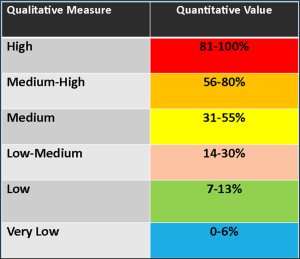
Source: (Nichols R. K., 2022)
CONCLUSION 1, THE SINGULARITY
“The Singularity is that point in or development time when artificially intelligent machines equal or surpass humans in intelligence.” (Barfiled, 2022)
Figure 5-23 The Singularity Timeline

Source: (Kurweil, 2005)
There is no one definition of the Singularity. Each futurist, or trans-humanist, applies their perspective to the overarching theme of rapid technological growth of genetics, nano-technological and robotics that is leading to a merger of man and machine. Or Cyborgs are inevitable.
Three interlocking developments are shaping the Singularity, genetics, nanotechnology, and robotics. An explanation of the progress towards the Singularity can be understood by applying Moore’s Law and Monsanto’s Law (Horner, 2008). Moore’s law states each new generation of computer chip provides twice as many components per unit cost, each of which operates faster the number of transistors that could fit on a single computer chip had doubled every year for six years from the beginnings of integrated circuits in 1959 and Monsanto’s law, which states that the ability to identify and use genetic information doubles every 12 to 24 months. These laws of accelerating returns leads to Ray Kurzweil’s Singularity definition “…It’s a future period during which the pace of technological change will be so rapid, its impact so deep, that human life will be irreversibly transformed.” (Kurweil, 2005).
One path leading to Kurzweil’s definition is his own Six Epochs of Evolution. His Epochs “… works through indirection; it creates a capability and then uses that capability to evolve to the next stage. Epoch One: Physics and Chemistry is the era of the emergence of patterns of matter and energy whilst Epoch Two: Biology and DNA represents the emergence of life and self-replicating organisms. Epoch Three: Brains – is the epoch of the emergence of ‘information in neural patterns’ leading to the human ability to conceive abstract models of the world. Epoch Four is the epoch of technology – seen in terms of the emergence of information technology and a rapid acceleration of technological evolution as compared with biological evolution. Epoch Five is the merger of human intelligence with machine intelligence. Epoch Six: The Universe Wakes Up this post-singularity period begins to be described as ‘…the ultimate destiny of the Singularity and of the universe’ (Kurweil, 2005).
Figure 5-24 The Six Epochs of Evolution
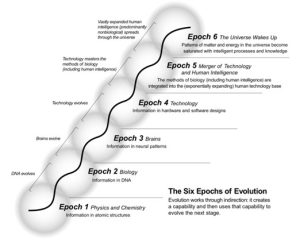
Source: (Kurweil, 2005)
Where do Cyborgs fit into The Singularity? An argument could be, they are riding the wave towards The Singularity. Consider the working definition used in this chapter, increasing human capability through mechanical or electrical means resulting in improved biological, bio-mechanical or neurological human abilities. Or Cyborgs are enhanced humans with increased capability, derived from the intersection of genetics, nanotechnology and robotics resulting in increased human abilities. Remember the scenario in Risk to Cyborgs, an enhanced human who has an RFID chip implanted in their organic limb, brain-controlled interface link to their external workstation and a neuro-link to their bionic limb. Individually, all of these occur today, circa 2023. Look quickly to the future and the Cyborg is working in Space, as the NASA studies of the 1960’s envisioned.
CONCLUSION 2, CYBORGS AND SPACE
“Altering man’s bodily functions to meet the requirements of extraterrestrial environments would be more than logical than providing an earthly environment for him in space…Artifact-organism systems which would extend man unconscious, self-regulatory controls are one possibility.” (Clynes & Kilne, 1960)
In 1960, scientists, researchers and futurists were thinking about the practical applicability of cyborgs supporting extra-terrestrial exploration. Two researchers, Manfred Clynes and Nathan Kline, in 1960 wrote about the biological impediments to man’s long term exploration of space, explaining that man’s adaption to the space environment by incorporating exogenous means would induce the biological changes allowing man to function, to “live in space qua natura” They argue that man as a cyborg, rather than monitoring external systems to keep him alive, “…is to provide an organizational system in which such robot-like problems are taken care of automatically and unconsciously, leaving man free to explore, to create, to think, and to feel.” (Clynes & Kilne, 1960).
Clynes and Kline discuss some of the various physiological and psychological problems man’s space travel would encounter. They determine the Cyborg will enhance man’s natural functions to increase his ability in extra-terrestrial environments, lasting from a few weeks to years. Functions they discuss include Wakefulness, Radiation Effects, Metabolic and Hypothermic Controls, Oxygenation and Carbon Dioxide Removal, Fluid Intake and Output, Enzyme Systems, Vestibular Functions, Cardiovascular Control, Muscular Maintenance, Perceptual Problems, Pressure, Variations in External Temperature, Gravitation, Magnetic Fields, Sensory Invariance and Action Deprivation, and Psychoses to be identified and controlled. (1960).
Figure 5-25 NASA “The Cyborg Study” design group requirements
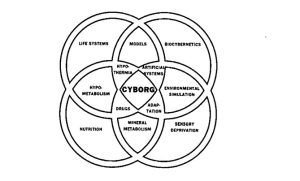
Source: (Driscoll, 1963)
Building off the Clynes and Kline research, NASA commissioned the CYBORG STUDY in 1963. The study’s goal is to continue the theoretical ideas proposed by Clynes and Kline, rather than modifying the environment, to physically adapt the human body to the rigors of living in space. As written by Robert Driscoll, the CYBORG Study is a “study of man and the theoretical possibility of incorporating artificial organism drugs and/or hypothermia as integral parts of life support systems in scale craft design of the future, and of reducing metabolic demands and the attendant life support requirements” (Driscoll, 1963). Clynes, Kline and Driscoll all recognized that man physiological structure is well-adapted to terrestrial life, and from the initial NASA manned space flights of the 1960’s, any future long-term extra-terrestrial endeavors require the study of how to adapt man’s biological and mental facilities to operate outside the physical parameters of Earth.
FINAL THOUGHTS
This chapter reviews current, circa 2023, research, development, and practical application of where humankind is regarding Cyborgs. Some define the human transition to cyborg when using any mechanical implementation to improve capability, from a simple bicycle to the pocket computers that are today’s smart devices. Following the origins of the word Cyborg, combining Cybernetic and Organism, incorporating external and internal components extending and expanding a human’s capability to adapt to new environments, this chapter presents a broad overview of prosthetics, bionic limbs, neural implants, and exoskeletons. The combining of Artificial Intelligence into prosthetics, brain-controlled interfaces and Augmented/Virtual reality long with the research into Nano-technology and neuro-interfaces point to future of where humankind could be headed as Cyborgs. Cyborgs are inevitable!
REFERENCES
Barfiled, W. (2022). Cyber-Humans.
Bast, M. (2014). You’ve given me my body back: A Q&A with Hugh Herr. Retrieved from TED Blog: https://blog.ted.com/youve-given-me-my-body-back-a-qa-with-hugh-herr/
BBC Click. (2017). The man with a camera inside his eye. Retrieved from BBC Click | Beyond Human: https://www.bbc.com/future/article/20170721-the-man-with-a-camera-inside-his-eye
Boroushaki, T., Lam, M., Dodds, L., Eid, A., & Adib, F. (2023). Augmenting Augmented Reality with Non-Line-of-Sight Perception. Massachusetts Institute of Technology, University of Michigan.
Britannica. (2022). Medicine Bionics Technology. Retrieved from Britannica: https://www.britannica.com/technology/bionics
Britannica. (n.d.). Cyborg. Retrieved from Encyclopedia Britannica: https://www.britannica.com/dictionary/cyborg
Brown, S. (2021, April 21). Machine Learning, explained. Retrieved from MIT Management Sloan School: https://mitsloan.mit.edu/ideas-made-to-matter/machine-learning-explained
Case, A. (2013). Steve Mann. Retrieved from Cyber Anthropology: http://cyborganthropology.com/Steve_Mann#cite_ref-3
Clynes, M., & Kilne, N. (1960). Cyborgs and Space. Astronautics.
Dann, A. (2015). TED Project: No Human Can Ever Be Broken! Retrieved from Avril Dann Illustrations: https://avrildannillustrations.wordpress.com/category/ted-project/
Darwin, C. (1859). The Origin of Species. London: John Murray, Ablemarle St.
Davis, N. (2023). Science Medical Research. Retrieved from The Guardian: https://www.theguardian.com/science/2023/mar/02/human-augmentation-with-robotic-body-parts-is-at-hand-say-scientists
Driscoll, R. (1963). Engineering Man for Space, The Cyborg Study. United Aircraft Corporate Systems Center.
Editors of Encyclopaedical Britannica. (2017). Britannica, Health & Medicine, Anatomy & Physiology. Retrieved from Britannica: https://www.britannica.com/science/exoskeleton-anatomy
Edwards, P. (2012). Lockheed Martin – HULC™. Retrieved from Peter Edwards GCIT 2012: https://peteredwards2012.wordpress.com/lockheed-martin-hulc/
Eveleth, R. (2014). ‘I was blind… now I have bionic eyes’. Retrieved from BBC’s Tomorrow’s Lives | Human Body: https://www.bbc.com/future/article/20140923-im-blind-but-i-have-bionic-eyes
Exoskeletons enable paraplegics to walk again. (2020). Retrieved from International Federation of Robotics: https://ifr.org/news/exoskeletons-enable-paraplegics-to-walk-again
Exoskelton Report. (n.d.). Exoskeleton Catalog. Retrieved from Exoskelton Report: https://exoskeletonreport.com/product-category/exoskeleton-catalog/
Ghose, T. (2017). Human Behavior | Arts & Entertainment. Retrieved from LiveScience : https://www.livescience.com/59470-eyeborg-project-photos.html
Gupta, A., Vardalakis, N., & Wagner, F. B. (2023). Neuroprosthetics: from sensorimotor to cognitive disorders. Communications Biology.
Harai, Y. (2016). Homo Deus. Harvill Secker.
Herr, H. (2014). The new bionics that let us run, climb and dance. Retrieved from TED: https://www.ted.com/talks/hugh_herr_the_new_bionics_that_let_us_run_climb_and_dance
Herr, H. (2018). How we’ll become cyborgs and extend human potential[Video]. Retrieved from TED: https://www.ted.com/talks/hugh_herr_the_new_bionics_that_let_us_run_climb_and_dance
Horner, D. S. (2008). Googling the Future: The Singularity of Ray Kurzweil. ETHICOMP, Living, Working and Learning Beyond Technology. University of Pavia.
Hsieh, T.-H. (n.d.). Agonist-antagonist Myoneural Interface (AMI). Retrieved from MIT Media Lab: https://www.media.mit.edu/dam/public/ami-images/
Jacobson, A. (2015). Engineering Humans for War. Retrieved from The Atlantic: https://www.theatlantic.com/international/archive/2015/09/military-technology-pentagon-robots/406786/
Kell, M. (2010). Myvision, an Ophthalmic Journal. Retrieved from The Eyeborg revealed: https://mivision.com.au/2010/09/the-eyeborg-revealed/
Kurweil, R. (2005). The Singularity is Near.
Kytaiko, A. (2023). Evolution human to robot cyborg, history man evolve. Retrieved from dreamstime: https://www.dreamstime.com/evolution-human-to-robot-cyborg-history-man-evolve-vector-ancestor-development-mankind-illustration-progress-primate-animal-ai-image198025128
Mann, S. (2012). Wearable Computing as Means for Personal Empowerment. Retrieved from Wearcopm.com: http://www.eyetap.org/defs/glossary/wearcomp/
Marinov, B. (., & Dao, T. (n.d.). What is an exoskeleton? Retrieved from Exoskeleton Report: https://exoskeletonreport.com/what-is-an-exoskeleton/
Marr, C. (2020). Forced Worker Microchipping Faces Growing Preemptive Strike. Retrieved from Bloomberg Law: https://news.bloomberglaw.com/daily-labor-report/forced-worker-microchipping-faces-growing-preemptive-strike
Max, T. (2017). Beyond Human. Retrieved from National Geographic: https://www.nationalgeographic.com/magazine/graphics/are-we-evolving-illustrations-stand-alone
McCarthy, J. (2006). Retrieved from John McCarthy’s Homepage: http://www-formal.stanford.edu/jmc/
Merriam-Webster. (2023). Cybernetics. Retrieved from Merriam-Webster Dictionary: https://www.merriam-webster.com/dictionary/cybernetics
Merriam-Webster. (2023). Cyborg. Retrieved from Merriam-Webster.com dictionary: https://www.merriam-webster.com/dictionary/cyborg
Merriam-Webster. (2023). Risk. Retrieved from Merriam-Webster Dictionary : https://www.merriam-webster.com/dictionary/risk
Michalowska, M. (2021). Proceedings of the International Online Conference. Medical University of Łódź.
MIT Media Lab. (n.d.). Agonist-antagonist Myoneural Interface (AMI). Retrieved from https://www.media.mit.edu/projects/agonist-antagonist-myoneural-interface-ami/overview
Muller, C. (2022). World Robotics 2022 – Industrial Robots. International Federation of Robotics.
Nature. (2023). Brain Machine Interface. Retrieved from Nature Portfolio : https://www.nature.com/subjects/brain-machine-interface
Nichols, R. K. (2002). Wireless security : models, threats, and solutions .
Nichols, R. K. (2022). Section 3.0 Cyber Risk Assessments – Ryan-Nichols Equations.
Oxley, T. (2022). A brain implant that turns your thoughts into text[Video]. Retrieved from TED: https://www.ted.com/talks/tom_oxley_a_brain_implant_that_turns_your_thoughts_into_text
Planck, M. L. (1949). Scientific autobiography, and other papers. . New York: Philosophical Library.
Rainie, L., Funk, C., Anderson, M., & Tyson, A. (2022). AI and Human Enhancement: Americans’ Openness Is Tempered by a Range of Concerns. Retrieved from Pew Research Center: https://www.pewresearch.org/internet/2022/03/17/ai-and-human-enhancement-americans-openness-is-tempered-by-a-range-of-concerns/
Saikia, R. (2023). Nanorobots. Retrieved from LinkedIn: https://www.linkedin.com/pulse/smart-machines-real-time-monitoring-imaging-prof-dr-rhituraj-saikia/?midToken=AQEtYE5SiRnxZA&midSig=25TjcTBMBkpqE1&trk=eml-email_series_follow_newsletter_01-newsletter_content_preview-0-title_&trkEmail=eml-email_series_follo
Saikia, R. (2023). The Possibility of AI Chip Implants in the Human Brain: Can We Merge with Machines?? Retrieved from LinkedIn: https://www.linkedin.com/pulse/possibility-ai-chip-implants-human-brain-can-we-merge-saikia/?midToken=AQEtYE5SiRnxZA&midSig=2YQctVSNOKmqE1&trk=eml-email_series_follow_newsletter_01-newsletter_content_preview-0-headline_&trkEmail=eml-email_series_follow_ne
Snyder, A. (2021). ‘Empower’ AMI Technique Gives New Life to Amputees. NIH Record .
Spence, R. (2014). The man with a camera inside his eye. (B. Click, Interviewer)
Swain, F. (2014). Why I want a microchip implant. Retrieved from BBC: https://www.bbc.com/future/article/20140209-why-i-want-a-microchip-implant
Swain, F. (2014). Why I want a microchip implant. Retrieved from BBC: https://www.bbc.com/future/article/20140209-why-i-want-a-microchip-implant
Thompson, K. (2022). Boston Marathon survivor Adrianne Haslet returns to race with assist from Olympian Shalane Flanagan. Retrieved from Boston.com: https://www.boston.com/sports/boston-marathon/2022/04/14/2022-boston-marathon-survivor-adrianne-haslet-shalane-flanagan/
Walters, H. (2013). The sound of color: Neil Harbisson’s talk visualized. Retrieved from Ideas. Ted.Com: https://ideas.ted.com/the-sound-of-color-neil-harbissons-talk-visualized/
Wang, Y., Liu, S., Wang, H., Zhao, Y., & Zhang, X.-D. (2022). Neuron devices: emerging prospects in neural interfaces and recognition. Retrieved from Nature.com Microengineering & Nanotechnology: https://www.nature.com/articles/s41378-022-00453-4#citeas
Warrick, K. (2017). Cyborgs: Understanding and Mutual Treatment. Principles of Gender-Specific Medicine., 705-715.
Warwick, K. (2000). Cyborg 1.0 . Retrieved from Wired : https://www.wired.com/2000/02/warwick/
Zomorodi, M., Gutierrez, A., & Meshkinpour, S. (2023). What if a brain was given technology? Retrieved from TED Radio Hour: https://www.npr.org/2023/03/17/1163988220/what-if-a-brain-was-given-technology

